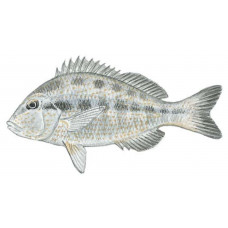Latin name
Orthopristis chrysoptera
Other names
Spanish: corocoro burro.Identification
Identification
The fish has long anal fins corresponding in shape and size to the soft dorsal fin. The head is sloping and pointed, the snout is almost pig-like, and the lips are thin. Against a background of bluish-gray color, there are brassy spots in the form of indistinct lines, which are horizontal below the lateral line, but obliquely extend upward and backward above the lateral line. These oblique marks are also present on the cheeks. The fins are yellow-bronze, with dusky margins.
Distribution
The fish inhabit the western Atlantic Ocean, from Massachusetts and Bermuda to the Gulf of Mexico. They are most abundant from the Chesapeake Bay southward and do not inhabit tropical waters.
Habitat
Occurs in coastal waters on sandy and muddy bottoms.
Size
Maximum length and weight is 18 inches and 2 pounds, but is usually 7 to 9 inches long and weighs no more than half a pound. They live for 3 years.
Life history and Behavior
These fish have a predominantly nocturnal lifestyle. Spawning takes place in the coastal zone in the spring and early summer, before the fish move into the estuaries.
Food and feeding habits
Fish are bottom feeders, feeding on crustaceans, worms and small fish.
Reproduction
No information
| Classification | |
| Phylum | Chordata |
| Class | Actinopterygii |
| Squad | Perciformes |
| Family | Haemulidae |
| Genus | Trachinotus |
| Species | O. chrysoptera |
| Features | |
| Conservation status | Least Concern |
| Habitat | Pelagic |
| Life span, years | 4 |
| Maximum body weight, kg | 0.9 |
| Maximum length, cm | 46 |
| Sailing speed, m/s | No information |
| Threat to people | Edible |
| Way of eating | Predator |
Pigfish
Tags: Pigfish


